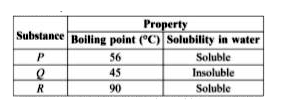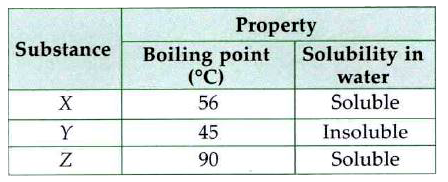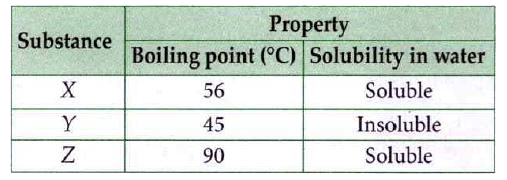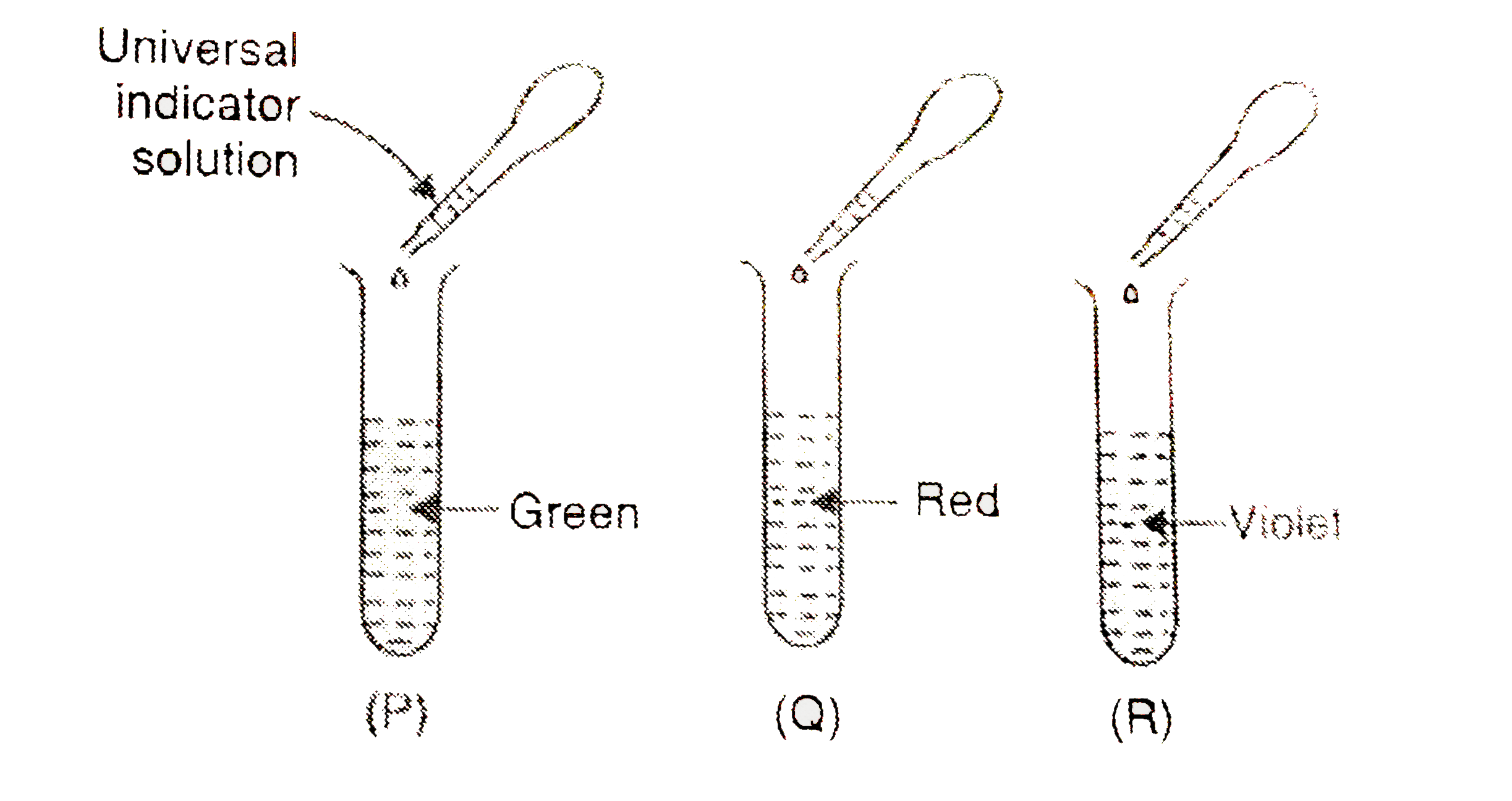Three students Renu, Manish and Raj were given three unknown liquids P, Q and R respectively during the lab activity.

On the basis of these properties, which student has chosen the correct separation technique to separate the substance from substance-water mixture?
Renu - Simple distillation
Manish - Separating funnel
Raj - Fractional distillation
All of these
The correct Answer is:D
Step by step video & text solution for Three students Renu, Manish and Raj were given three unknown liquids P, Q and R respectively during the lab activity. On the basis of these properties, which student has chosen the correct separation technique to separate the substance from substance-water mixture? by Chemistry experts to help you in doubts & scoring excellent marks in Class 10 exams.
Updated on:21/07/2023Topper's Solved these Questions
- NSO QUESTION PAPER 2018 SET ABOOK - SCIENCE OLYMPIAD FOUNDATION CHAPTER - NSO QUESTION PAPER 2018 SET AEXERCISE - Achievers Section
2 Videos
- NSO QUESTION PAPER 2017 SET BBOOK - SCIENCE OLYMPIAD FOUNDATION CHAPTER - NSO QUESTION PAPER 2017 SET BEXERCISE - Achievers Section
2 Videos
- NSO QUESTION PAPER 2018 SET BBOOK - SCIENCE OLYMPIAD FOUNDATION CHAPTER - NSO QUESTION PAPER 2018 SET BEXERCISE - ACHIEVERS SECTION
2 Videos
Similar Questions
Dicky, Micky and Vicky had three liquids, A, B and C respectively. They mixed these liquids and observed that they form a homogeneous mixture. They wer unable to separate the liquids and asked their teacher to separate these for them. The teacher subjected the given mixture to fractional distillation. Liquid B was obtained in the receiver flask. On further distillation, A was left behind in the distillation flask. On the basis of the results, comment on the critical temperatures of A, B and C in their respective gaseous states.
View SolutionRamnik is a student of class 9. One day he was studying a chapter of chemistry in the class alongwith other students. The teacher, Mr. Bhagi, told the students that the scientists James Chadwick J.J. Thomson and E. Goldstein had discovered three subatomic particles P, Q and R, respectively. He gave the characteristics of all these particles, their locations and arrangements in the atom. Mr. Bhagi also described the contributions of scientists Ernest Rutherford and Neils Bohr in this regard. After completing the discussion on this chapter, Mr. Bhagi asked Ramnik to answer the following question :
(a) What is the name of particle P ? What is the nature of charge on it ? State its location in tha atom
(b) What is the name of particle Q ? What is the nature of charge on it ? State its location in the atom
(c) What is the name of particle R ? What is the nature of charge on it ? State its location in the atom
(d) (i) Which of the particles P,Q and R is not present in an ordinary hydrogen atom
(ii) Which of the particles P,Q and R is not present in an alpha particle ?
(e) What is the total number of P and R particles present in one atom of an element known as ?
. (f) The number of particles Q in one neutral atom of an element is nineteen. How are these particles arranged in various energy levels in the atoms ?
(g) What values are displayed by Ramnik in this episode ?
View Solution
Knowledge Check
Three students Ankit, Dinesh and Manoj were given three unknown substances X, Y and Z respectively during the lab activity.

On the basis of these properties, which student has chosen the correct separation technique, to separate a substance from the substance-water mixture?AAnkit - Separating funnelBDinesh - DistillationCManoj - Fractional distillationDAll are correct.Three students Ankit, Dinesh and Manoj were given three unknown substances X, Y and Z respectively during the lab activity.

On the basis of these properties, which student has chosen the correct separation technique, to separate a substance from the substance-water mixture?AAnkit - Separating funnelBDinesh-DistillationCManoj – Fractional distillationDAll are correctOn adding a few drops of universal indicator solution to three unknown colourless solutions P,Q, and R taken separately in three test-tubes shown in the diagrams, a student observed the changes in colour as green in solution P red in solution Q and violet in solution R.
The decreasing order of the pH of the three solutions is:
 AP>Q>RBR>P>QCQ>P>RDR>Q>P
AP>Q>RBR>P>QCQ>P>RDR>Q>P
A student was–performing an activity to prove the requirements for photosynthesis. During this activity, he kept two identical healthy potted plantsA and Bin dark for 72 hours. After 72 hours, he covered plant A and B by bell shaped jars separately. While covering the plants with separate bell jars, he kept KOH in the watch glass by the side of the plant in setup A and not in setup B. Both these setups were made air tight and were kept in light for 6 hours. Then, Iodine Test was performed with one leaf from each of the two plants A and B.
Which of the following statements shows the correct results of Iodine Test performed on the leaf from plant A and B respectively?
View SolutionAbhinav is a student of class IX. One day all the students were performing experiments in the science laboratory. Just then, the chemistry teacher, Mrs. Prasad, came to the laboratory. She had three beaker in her hands labelled A, B and C. All the beakers contained colourless liquids which looked exactly the same. Mrs. Prasad turned to the students and said that one of the beakers contained a pure substance whereas the other two beakers contained solutions of the same solute in the same solvent but different concentrations. She also told the students that the weight one of the three beakers A, B and C were 110g, 120g and 100g respectively. Mrs. Prasad wanted one of the students to find out experiementally which beaker contained a pure substance and which two beakers contained solutions. She also wanted them to show experimentally two properties which could tell why the solutions are considered mixtures, even though they are homogeneous substances. Mrs. Prasad wanted one of the the students to find out experimentally which beaker contained a pure substance and which two beakers contained solutions. She also wanted them to show experimentally two properties which could tell why the solutions are considered mixtures, even though they are homogeneous substances. Mrs. Prasad allowed them to use any required apparatus from the laboratory for the purpose. Abhinav offered to perform the experiements to distinguish between the pure substance and solutions and also to show experimentally why solutions are considered mixtures.
(a) What did Abhinav do to find out which of the given liquids is a pure substances and which liquids are solutions ? What were the observations made by Abhinav ?
(b) Whay did Abhinav conclude form the above observations ?
(c) Which property of the pure substance is exhibited by this experiment ?
(d) Which properties of a solution are exhibited in this experiement ?
(e) What values are displayed by Abhinav in this episode ?
View SolutionA solid substance P which is very hard is used in the construction of many buildings epiecialy flooring When substance P is heated strongly, it decompose to from another soolid Q and a gas R is given our Solid Q reacts with water with the releade of a lot of heat to from a substance S. When gas R is passed into a clear solutio of substance S, then a while precipitate of substance T is formed. The substance T has the same chemical composition as starting substance P.
(a) What is substance P? Write its common name as well as chemical formula.
(b) What is substance Q?
(c ) What is gas R?
(d) What is substance S ? What is its clear solution known as ?
(e) What is substance T ? Name any two natural forms in which substance T occurs in nature
View SolutionThree copper wires of length and cross-sectional areas are (L,A)(2L,A2),(L/2,2A), resistance is
View SolutionStudy the following information carefully and answer the given questions.
P. Q, R, S, T, W and Z are seven students studying in three different institutes-A, B and C. There are three girls among the seven students who study in each of the three institutes. Two of the seven students study BCA, two study medicine and one each studies Aviation Technology, Journalism and MBA. R studies in the same college as P, who studies MBA in college B. No girl studies Journalism or MBA. T studies BCA in college A and his brother W studies Aviation Technology in college C. S studies Journalism in the same college as Q. Neither R nor Z studies BCA. The girl who studies BCA does not study in college C.
Which of the following pairs of students study medicine?
View Solution
